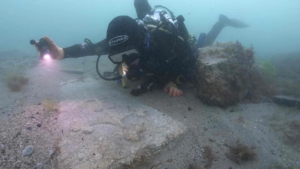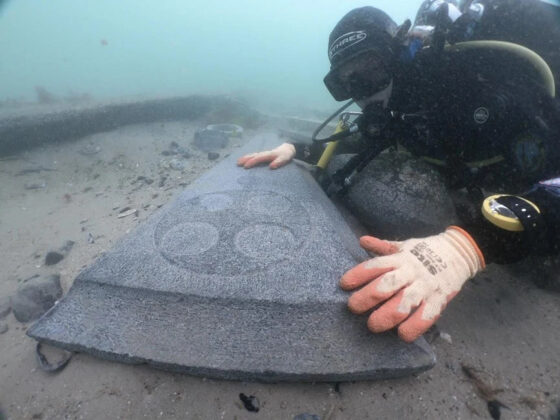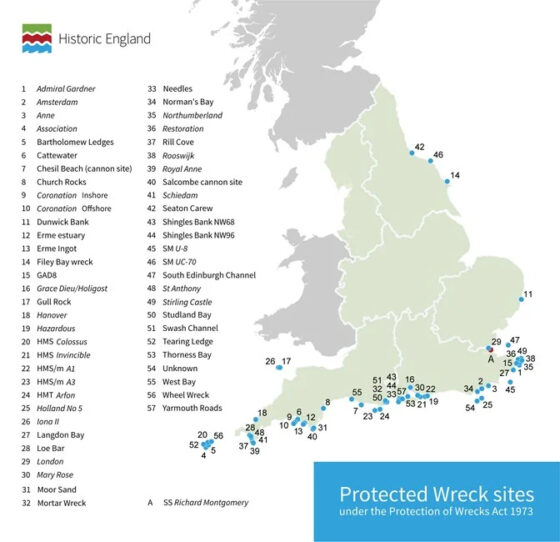
England’s oldest shipwreck, discovered in Poole, given protected status

Three exceptionally rare shipwrecks discovered off the Isle of Wight and Dorset coasts – including the oldest shipwreck in England – have been granted the highest level of protection by the government on the advice of Historic England.
The remains of the medieval ship Mortar Wreck made from trees felled over 750 years ago has been designated the oldest shipwreck in English waters where the remains of the hull are still visible. It is one of three extremely rare shipwrecks that have been granted the highest level of protection by the Secretary of State for Culture, Nadine Dorries.
The 13th-century Mortar Wreck discovered in Poole Bay in Dorset with its cargo of gothic Purbeck stone gravestones is the oldest known protected wreck in English waters where hull remains can be seen. Tree ring dating of the wreck indicates that the timbers used to construct the hull are from Irish oak trees, felled between 1242-1265, during the reign of King Henry III.

One of the Purbeck stone gravestone slabs discovered on the 13th-century ‘Mortar Wreck’ © Bournemouth University
The survival of 13th century vessels is extremely rare, and prior to this discovery, there are no known wrecks of seagoing ships from the 11th to the 14th century in English waters. The wreck was discovered by Trevor Small who has operated diving charters from Poole in Dorset for the past 30 years.
The other two wrecks – the 16th century Shingles Bank Wreck NW96 and 17th century Shingles Bank Wreck NW68 were both discovered off the Needles Channel by divers Martin Pritchard and Dave Fox and have now been designated under the Protection of Wrecks Act 1973.
According to Historic England, the survival of pre-1700 ships is extremely rare, as is the unearthing of previously unrecorded wreck sites in the Solent, making these discoveries nationally significant.
Nigel Huddleston, Heritage Minister says: “These fascinating shipwrecks can reveal so much to us about our national history and it is right that we protect them for future generations. The survival of the 13th-century Mortar Wreck is particularly rare, with timbers dating to Henry III’s reign, and the 16th and 17th-century Shingle Bank Wrecks shed light on historical trading.”
Historic England states: ‘The three shipwrecks from the 13th, 16th and 17th centuries are very important discoveries and deserve the highest level of protection. The 13th-century ship with its cargo of medieval Purbeck stone is fascinating because it is the earliest English protected wreck site where hull remains are present, while the Shingles Bank wrecks’ ordnance and cargo reveal a wealth of information about life and trade many centuries ago.’
There are currently 57 wrecks designated under the Protection of Wrecks Act 1973 in England.

Illustration courtesy of Historic England
The Mortar Wreck
Items recovered from England’s oldest shipwreck, the Mortar Wreck, include two Purbeck stone gravestone slabs from Dorset, with two different gothic designs. Historic England says they are in immaculate condition and the chisel marks can still be seen. These gravestones are found in church graveyards across the south coast.
Other finds include a large cauldron for cooking soup, a smaller cauldron and mugs. Several Purbeck stone mortars used by millers to grind grains into flour have also been recovered.
One theory is that the ship may have been lost on its way out from the Dorset coast. Its destination is unknown. Historic England has been working closely with Bournemouth University and Trevor Small to investigate this wreck. Irish oak was widely exported for shipbuilding during the Medieval period and Purbeck marble gravestone slabs were widely used across the south of England and were exported to Ireland and the continent.
